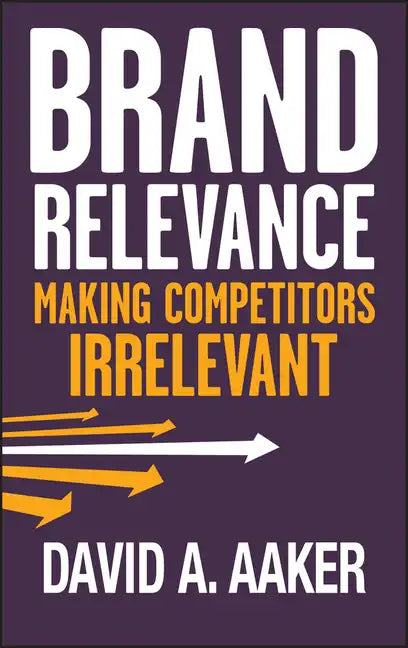Brand Relevance - Hardcover
Brand Relevance - Hardcover
Couldn't load pickup availability
by Aaker (Author)
Branding guru Aaker shows how to eliminate the competition and become the lead brand in your market
This ground-breaking book defines the concept of brand relevance using dozens of case studies-Prius, Whole Foods, Westin, iPad and more-and explains how brand relevance drives market dynamics, which generates opportunities for your brand and threats for the competition. Aaker reveals how these companies have made other brands in their categories irrelevant. Key points: When managing a new category of product, treat it as if it were a brand; By failing to produce what customers want or losing momentum and visibility, your brand becomes irrelevant; and create barriers to competitors by supporting innovation at every level of the organization.
- Using dozens of case studies, shows how to create or dominate new categories or subcategories, making competitors irrelevant
- Shows how to manage the new category or subcategory as if it were a brand and how to create barriers to competitors
- Describes the threat of becoming irrelevant by failing to make what customer are buying or losing energy
- David Aaker, the author of four brand books, has been called the father of branding
This book offers insight for creating and/or owning a new business arena. Instead of being the best, the goal is to be the only brand around-making competitors irrelevant.
Front Jacket
This ground-breaking book clearly defines the concept of brand relevance and shows what it takes to channel innovation and manage the competitive arena so that competition is reduced or eliminated.
Throughout the book, branding guru David Aaker explains how brand relevance drives market dynamics using dozens of illustrative case studies involving brands such as Asahi Beer, Prius, Whole Foods Market, Hyundai, Zappos, Wheaties Fuel, Zipcar, Muji, Cafe Steamers, GE, SalesForce.com, and Apple. He reveals how brand teams have turned away from destructive brand preference competition by making other brands irrelevant.
Adopting Aaker's brand relevance model--in which innovative offerings form categories and subcategories--provides dramatic opportunities for brand teams with insight and the ability to lead the market. As Aaker explains, successful brand relevance competition involves four vital tasks: concept generation, concept evaluation, creating barriers to the competition and, critically, actively defining and managing the new category or subcategory. It also involves being on top of the market, the competition, and the technology so that they get the timing right, a crucial element of a successful brand relevance strategy.
Brand relevance is a threat as well as an opportunity to firms facing dynamic markets. Aaker shows how to avoid having a brand go into decline because people no longer consider it relevant.
Brands that can create and manage new categories or subcategories making competitors irrelevant will prosper while others will be mired in debilitating marketplace battles or will be losing relevance and market position.
Back Jacket
THIS GROUND-BREAKING BOOK
clearly defines the concept of brand relevance and shows what it takes to channel innovation and manage the competitive arena so that competition is reduced or eliminated.
Throughout the book, branding guru David Aaker explains how brand relevance drives market dynamics using dozens of illustrative case studies involving brands such as Asahi Beer, Prius, Whole Foods Market, Hyundai, Zappos, Wheaties Fuel, Zipcar, Muji, Cafe Steamers, GE, SalesForce.com, and Apple. He reveals how brand teams have turned away from destructive brand preference competition by making other brands irrelevant.
Adopting Aaker's brand relevance model--in which innovative offerings form categories and subcategories--provides dramatic opportunities for brand teams with insight and the ability to lead the market. As Aaker explains, successful brand relevance competition involves four vital tasks: concept generation, concept evaluation, creating barriers to the competition and, critically, actively defining and managing the new category or subcategory. It also involves being on top of the market, the competition, and the technology so that they get the timing right, a crucial element of a successful brand relevance strategy.
Brand relevance is a threat as well as an opportunity to firms facing dynamic markets. Aaker shows how to avoid having a brand go into decline because people no longer consider it relevant.
Brands that can create and manage new categories or subcategories making competitors irrelevant will prosper while others will be mired in debilitating marketplace battles or will be losing relevance and market position.
Author Biography
DAVID A. AAKER is vice chairman of Prophet Brand Strategy, an executive advisor to Dentsu Inc., and Professor Emeritus of Marketing Strategy at the Haas School of Business, University of California, Berkeley.


